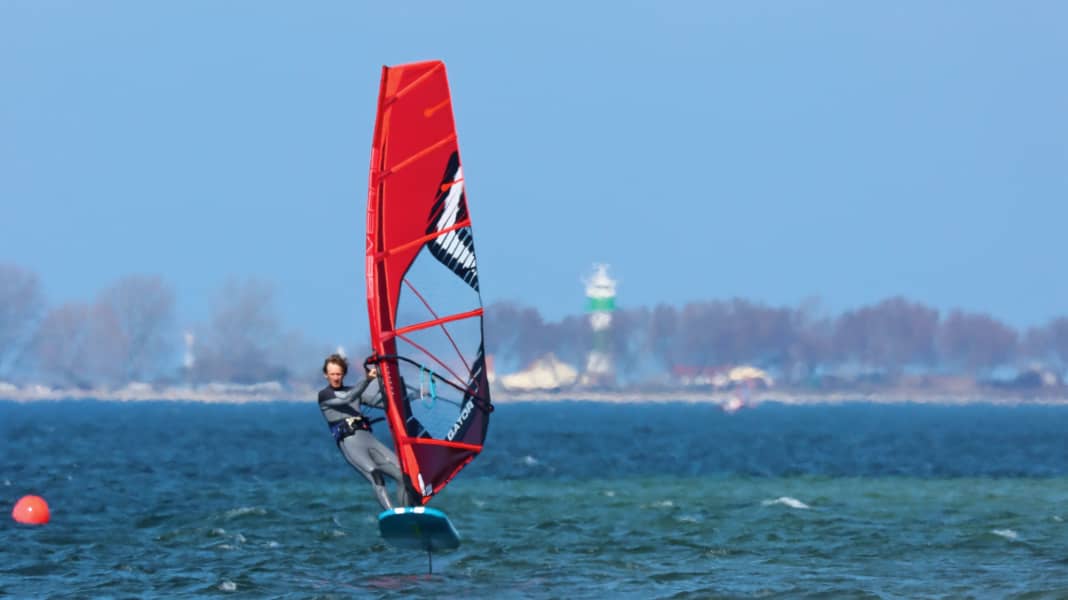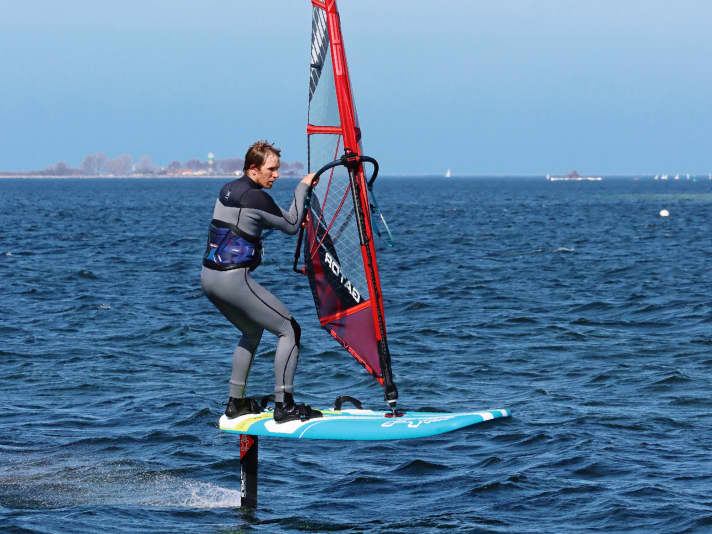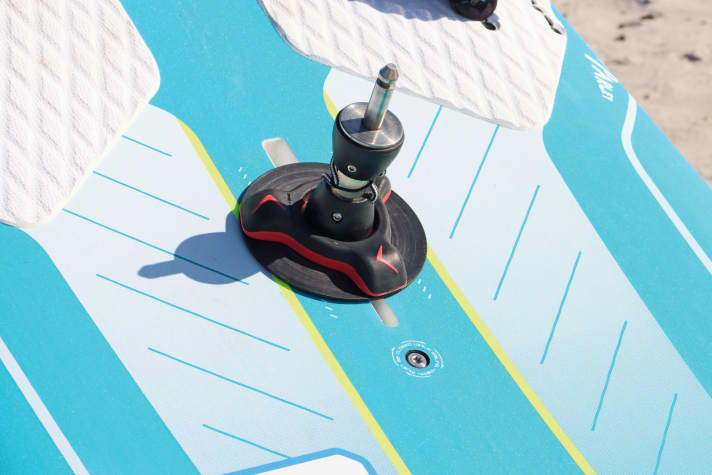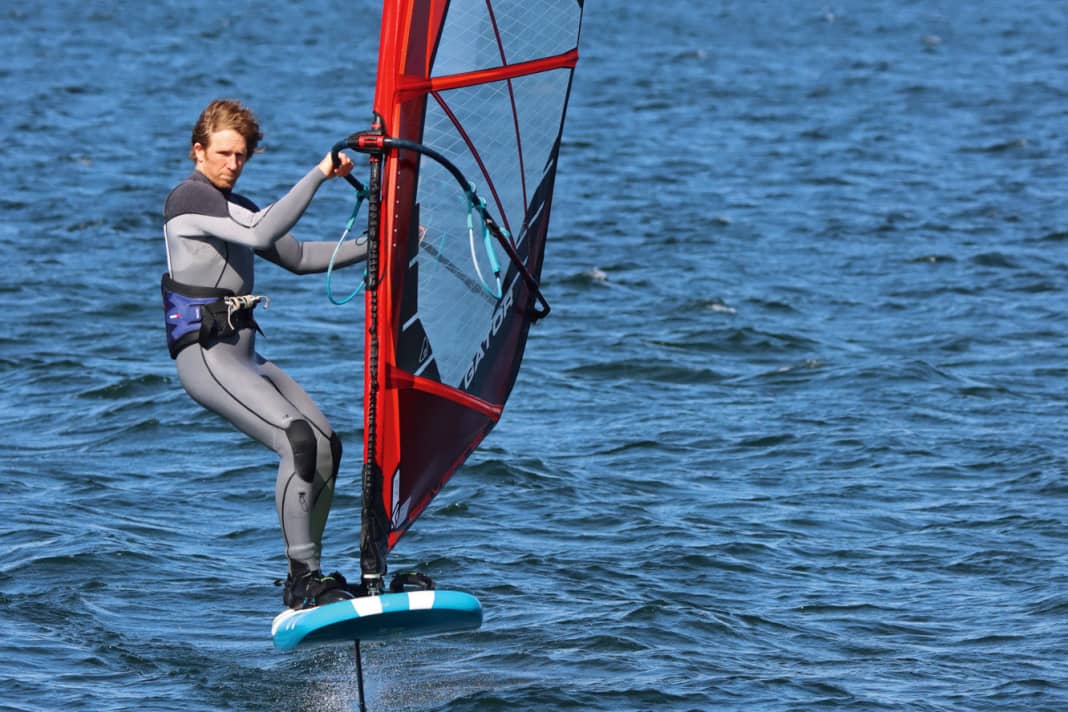Foil basics: Controlled flying, tuning equipment & jibing safely on the foil
Manuel Vogel
· 21.04.2023

In this article:
Other parts of the Foil series:
When foiling, the ultimate goal is control. If you have control, you can enjoy yourself and fly along relaxed and silently. Without control, on the other hand, foiling becomes a ride on a cannonball. It is as well known as it is understandable that manufacturers would prefer to sell special products for every area of use. So it's no wonder that pure foil sails have long since found their way into the product ranges of most brands, also with the promise of "more controlled" flying.
But what is the difference between special foil sails and "normal" windsurfing sails? What are the advantages and disadvantages of both concepts and how can you tune your windsurf sail for foiling if you don't want your fleet to grow any further? We want to answer these questions below.

Foil sails vs. windsurf sails
Pure foil sails differ from windsurf sails in the following design features:
- Outline: In windsurfing sails, the leech should be loose, which allows the sail to twist at the top, improves control in the chop and ensures that the board can accelerate freely over the wind waves. Without loose leech, windsurf sails would be top-heavy, i.e. they would get too much pressure in the upper area and thus push the board nose downwards - a free planing position and high top speed would hardly be possible. However, this is exactly what foil sails should be able to do - deliberately keep the bow down to prevent the foil from rising uncontrollably. For this reason, the leech remains taut in normal trim with pure foil sails - the sail top develops pressure on the tip of the board, so the bow does not rise uncontrollably so quickly.
- boom length: For windsurfing sails, a correspondingly long boom and a pressure point that is slightly offset to the rear should make it possible to exert pressure on the fin. This in turn results in a free ride, the bow gets some lift and the board flies freely over the chops. Foil sailing is different: It is absolutely undesirable for the tip of the board to rise, which is why the pressure point is significantly further forwards and the boom is shorter.
- Profile hardness: Windsurf sails should remain stable over a wide wind range. To ensure this, tension must be applied to the rig. This is achieved, for example, by a stronger mast bend and the associated higher trimming forces. In contrast, special foil sails generally have to function in the light wind range and are optimised precisely for this: Small camber fixes the profile far forward, but the rig itself manages with noticeably less tension.
Conclusion: The bottom line is that pure foil sails are optimised for special windfoiling applications. This means you get 100 per cent foil suitability with 30 per cent windsurfing suitability. Windsurf sails offer an average of 80 per cent foil suitability and 100 per cent windsurf suitability and therefore have a wider range of use.
Tuning windsurf sails for foiling
Many windsurfers want to keep it simple, which means using the same sail for foiling and windsurfing. The good news is that with many freemove, wave, freeride or freerace sails you can foil really well, as long as you make a few adjustments. Therefore, our tip: apply less luff tension than normal so that no or very little loose leech is visible in the leech! The tighter leech tension deliberately makes the sail a little "top-heavy", which keeps the bow down better and can prevent the foil from rising uncontrollably.
How to get more control when foiling
If you feel that the board keeps rising unintentionally, e.g. in a gust, the influence you can exert by opening the sail is much less than when surfing with a fin. Shifting your body weight clearly has a greater effect.

To keep the bow down and prevent the foil from stalling, bring your upper body far forwards from the normal riding position (bend at the hips). In this upright position, you can exert pressure on the mast foot via the boom and keep the bow down. As soon as the flying height has levelled out again, you can return to the normal riding position and place your body weight outwards again in a controlled manner.
Loop position

When learning to foil surf, a slightly more inward strap position can be helpful as it is easier to slip in. So if you don't have any experience with straps that are far out, e.g. from slalom or freerace boards, start with straps that are offset inwards. If you are already confident in the straps and can lift off, you can then move the straps slightly outwards again. This gives you better leverage and more power to counter the forces of the foil - which improves control.
Mast foot position

The mast foot position can be used to influence the general trim of the board-foil combination. If you have the feeling that you always have to keep the bow actively
actively keep the bow up to prevent it from slapping back onto the water, it is best to push the mast foot back slightly. If, on the other hand, the board keeps rising uncontrollably, moving the mast foot forwards can help you to exert more pressure on the bow and thus improve control.
Foil position

Many brands now use a double rail to attach the foil, at least for pure foil boards. The advantage: if you push the foil further forwards, this usually helps the board to take off early - a tip for foil surfing in wind conditions at the lower limit. Conversely, the problem of a board rising uncontrollably in gusts can also be solved by moving the foil a few centimetres further back.
The first jibe in foilsurfing






It will take some time before you can completely foil your first jibe. At the beginning, it makes sense to approach it slowly and start practising in underpowered conditions. The aim at the beginning should always be a "controlled take-off" - consciously keep the board flat and at a low flying height in every phase. The more practice you have, the longer you can delay the intermediate landing - in the end beyond the downwind course. In this way, you can gradually get closer to the foiled jibe.
You can also find tips on jibing when foilsurfing in this clip:
Other parts of the Foil series:

